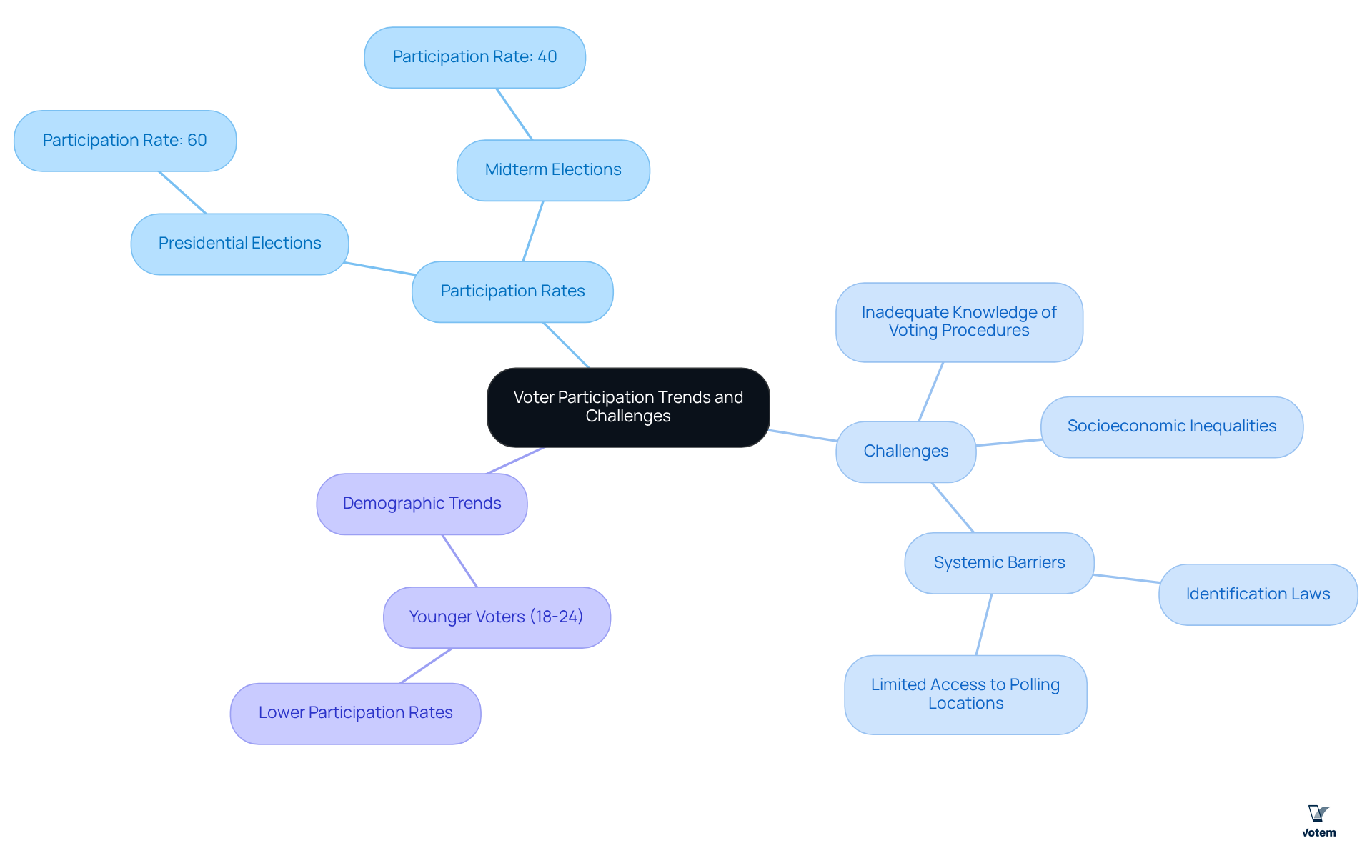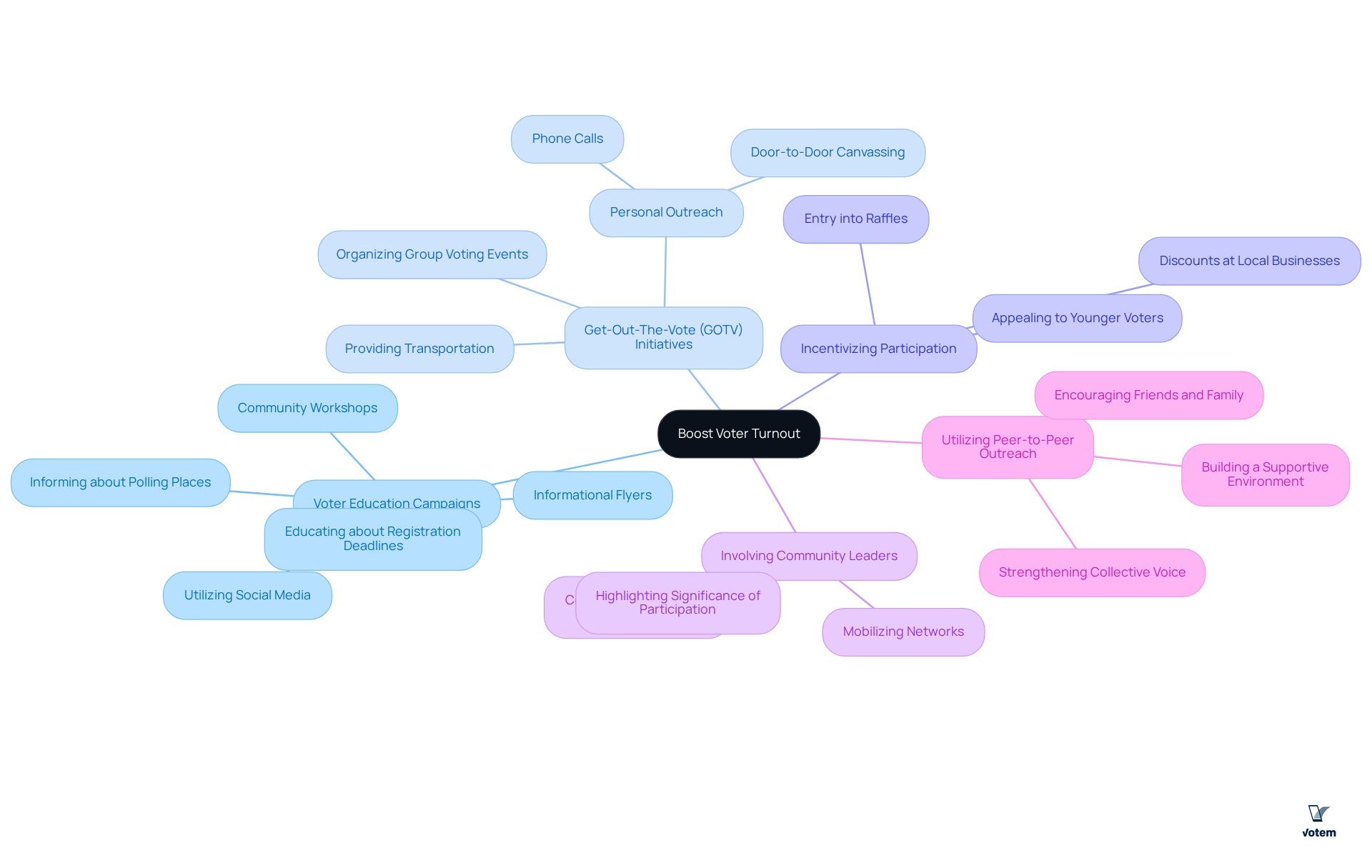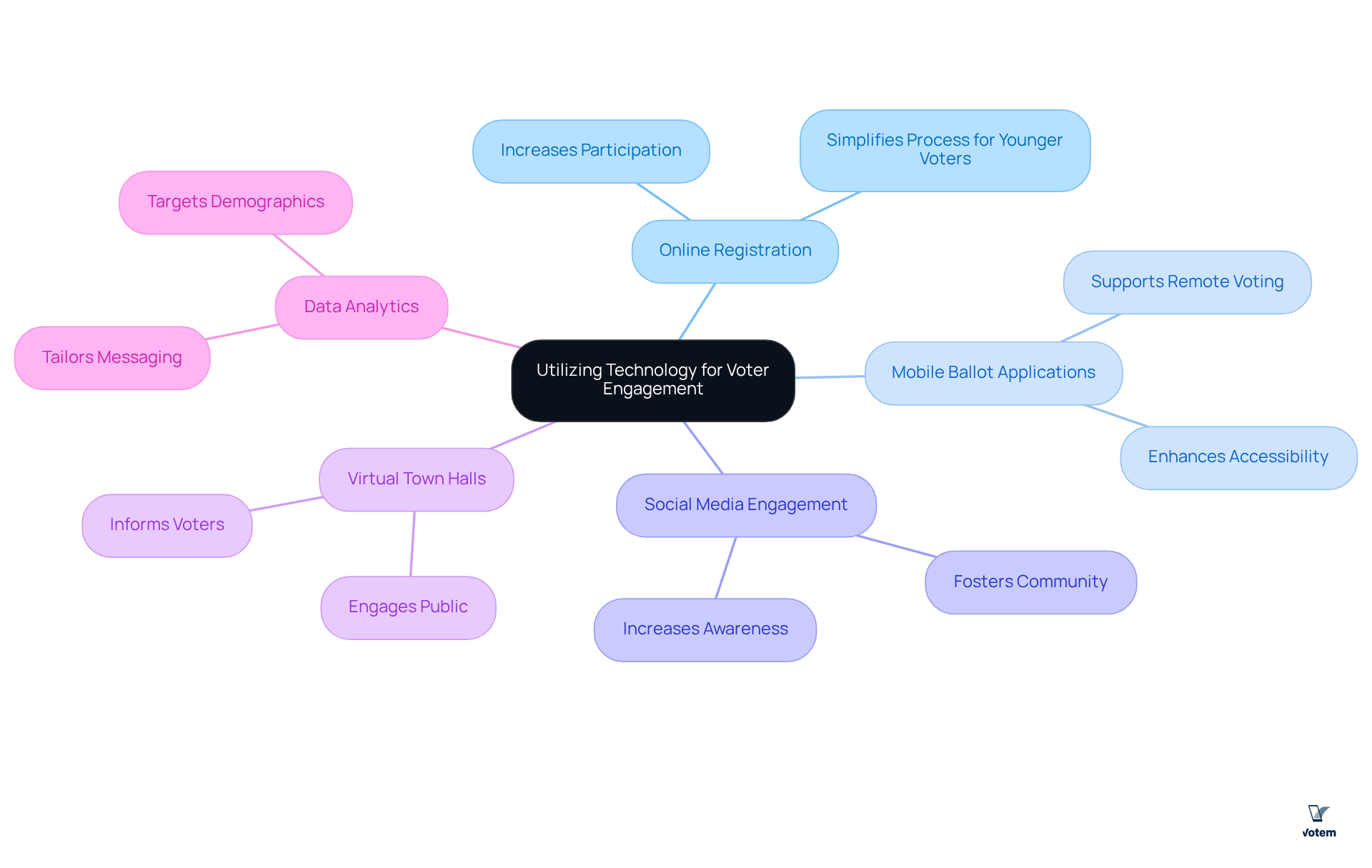Overview
This article examines effective strategies aimed at enhancing voter engagement and turnout, addressing the current trends and challenges that impact voter participation. It presents a variety of approaches, such as:
- Voter education campaigns
- Get-Out-The-Vote initiatives
- The integration of technology
These strategies are supported by research demonstrating their effectiveness in overcoming barriers to participation and fostering a more inclusive electoral process.
Furthermore, the article highlights the importance of these initiatives in mobilizing voters, as they not only inform but also empower individuals to take action. By leveraging technology and innovative outreach methods, we can significantly increase participation rates. In addition, the article emphasizes the need for continuous adaptation to changing circumstances, ensuring that our approaches remain relevant and impactful.
Ultimately, the insights provided here serve as a call to action for union leadership, encouraging the implementation of these strategies to create a more engaged electorate. By prioritizing voter education and utilizing proven methods, we can pave the way for a stronger democratic process that truly reflects the voices of all citizens.
Introduction
Voter participation stands as a fundamental pillar of democracy; however, numerous individuals encounter substantial obstacles that impede their involvement in the electoral process. Participation rates exhibit considerable variation between presidential and midterm elections, making it crucial to comprehend the underlying challenges—ranging from socioeconomic disparities to systemic barriers. Such an understanding is vital for cultivating a more inclusive electoral environment.
What innovative strategies can organizations adopt to not only elevate turnout but also empower individuals, particularly younger voters, to amplify their voices? This article explores established tactics and contemporary technological solutions designed to enhance voter engagement, ensuring that every vote is counted.
Assess Current Voter Participation Trends and Challenges
To effectively enhance , it is imperative to assess current trends and challenges. Recent studies indicate that participation in the United States hovers around 60% during presidential elections, while it plummets to approximately 40% in midterm elections. Factors contributing to this low voters participation include:
- Socioeconomic inequalities
- Inadequate knowledge of voting procedures
- Systemic barriers such as identification laws and limited access to polling locations
Furthermore, demographic analyses reveal that younger individuals, particularly those aged 18 to 24, consistently demonstrate lower participation rates compared to older age groups. By comprehending these trends, organizations can tailor their outreach efforts to address specific barriers faced by underrepresented groups, ultimately fostering voters participation in a more inclusive electoral process.

Implement Proven Strategies to Boost Voter Turnout
To boost voter turnout, organizations can implement several proven strategies that not only enhance participation but also empower individuals within the community.
- Voter Education Campaigns: Educating voters about the election process—including registration deadlines and polling places—can significantly enhance participation. Utilizing social media, community workshops, and informational flyers effectively . Furthermore, these campaigns can create a knowledgeable electorate that is better prepared to engage in the democratic process.
- Get-Out-The-Vote (GOTV) Initiatives: Mobilizing efforts on election day, such as providing transportation to polling places or organizing group voting events, encourages individuals to cast their ballots. Research indicates that personal outreach, like phone calls or door-to-door canvassing, can boost participation by 5-10%. This direct engagement not only facilitates voting but also reinforces the importance of each individual’s voice in the electoral process.
- Incentivizing Participation: Offering incentives—such as discounts at local businesses or entry into raffles for those who vote—can motivate individuals to participate in elections. This approach has been shown to increase turnout, particularly among younger voters. By making voting more appealing, organizations can tap into a demographic that is often underrepresented in the electoral process.
- Involving Community Leaders: Collaborating with trusted local influencers to promote electoral engagement can enhance credibility and stimulate involvement. Leaders can mobilize their networks and highlight the significance of participation in achieving community objectives. Their endorsement can serve as a powerful motivator for others to engage in the voting process.
- Utilizing Peer-to-Peer Outreach: Engaging peers to encourage their friends and family to vote creates a supportive environment that fosters participation. Studies indicate that individuals are more likely to vote when encouraged by someone they know. This grassroots approach not only builds community but also strengthens the collective voice of the electorate.
By implementing these strategies, organizations can create a culture of voting that empowers individuals and increases overall turnout. The time for action is now—let us work together to ensure that every voice is heard in our democracy.

Utilize Technology to Enhance Voter Engagement and Accessibility
Technology plays a crucial role in enhancing voters participation and accessibility in the electoral process. Organizations can leverage technology in several impactful ways:
- Online registration for electors simplifies the process for participants, particularly younger individuals who are more comfortable with digital platforms. Research indicates that states with online registration experience greater voters participation rates, underscoring its importance in modern electoral processes.
- Furthermore, the creation of secure mobile ballot applications can significantly enhance accessibility. This allows individuals to submit their ballots from any location, which is especially beneficial for those facing mobility challenges or residing in remote areas.
- In addition, utilizing social media platforms to engage the public can dramatically increase awareness and voters participation. Campaigns encouraging users to share their voting experiences foster a sense of community and motivate others to vote, thereby enhancing voters participation and amplifying the collective voice of the electorate.
- Conversely, hosting virtual town halls and forums provides an opportunity for online discussions and Q&A sessions with candidates. This format engages the public and equips them with the necessary information to make informed choices, , particularly among those unable to attend in-person events.
- Lastly, employing data analytics for targeted outreach can enhance engagement efforts. By identifying and understanding specific demographics, organizations can tailor their messaging and strategies to connect effectively with various groups.
By embracing technology, organizations can create a more inclusive and engaging electoral process that fosters voters participation and meets the needs of all voters.

Conclusion
Enhancing voter participation is essential for fostering a robust democratic process, requiring a multifaceted approach to address barriers that hinder engagement. Understanding current trends and challenges allows organizations to implement targeted strategies that not only boost turnout but also empower citizens to actively participate in shaping their communities.
Key strategies highlighted in the article include:
- Voter education campaigns
- Get-Out-The-Vote initiatives
- Incentivizing participation
- Leveraging community leaders for outreach
Furthermore, the integration of technology—such as online registration, mobile ballot applications, and social media engagement—can significantly enhance accessibility and encourage broader participation. Together, these approaches create a supportive environment that motivates individuals to exercise their right to vote.
Ultimately, the responsibility to increase voter participation lies with everyone. By adopting these best practices and embracing innovative solutions, communities can work collaboratively to ensure that every voice is heard. Engaging in this effort not only strengthens democracy but also empowers individuals to take an active role in the decision-making processes that affect their lives. The time to act is now—let’s commit to making a difference in voter engagement and turnout for a more inclusive future.
Frequently Asked Questions
What are the current voter participation rates in the United States?
Voter participation in the United States is approximately 60% during presidential elections and around 40% during midterm elections.
What factors contribute to low voter participation?
Factors contributing to low voter participation include socioeconomic inequalities, inadequate knowledge of voting procedures, and systemic barriers such as identification laws and limited access to polling locations.
Which demographic group shows the lowest voter participation rates?
Younger individuals, particularly those aged 18 to 24, consistently demonstrate lower participation rates compared to older age groups.
How can organizations improve voter participation?
Organizations can improve voter participation by assessing current trends and challenges, and tailoring their outreach efforts to address specific barriers faced by underrepresented groups.

